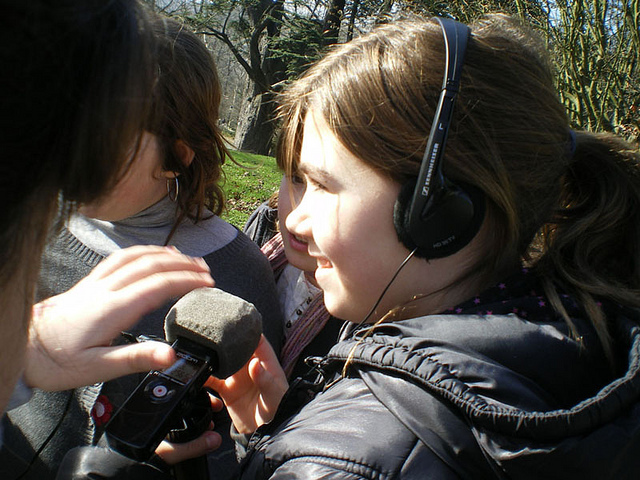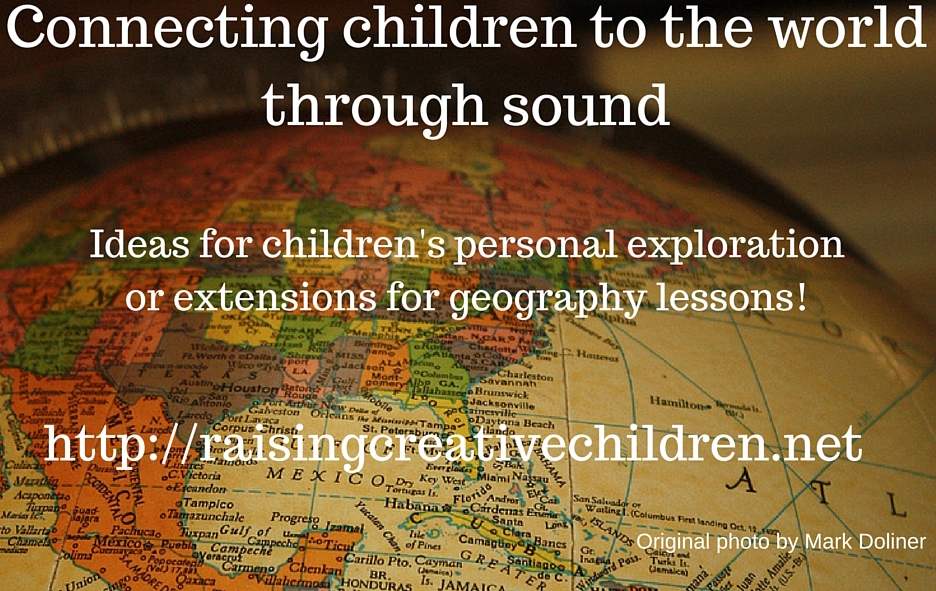Do you think it is important for children to know more about the world?
While traveling around the world is one way to experience new places and people, the Internet is a fabulous tool for bringing the world to your home or school. Experiencing the sounds of foreign places is a wonderful way for young people to become more aware of the world around them.
This is also a great way to add sound to a child’s interest or lessons in geography! While there are resources for [affiliate links] learning geography through art or learning geography through food , we hope this post inspires you to include music and sound when helping young people explore the world!
Engaging With Music From Around the World
One of the most engaging ways to connect young people to other countries through sound is through what Patricia Sheehan Campbell calls active, engaged, and enactive listening. The amazing [affiliate link] Experiencing Music Expressing Culture Global Music Series includes a number of books, each focusing on a particular musical culture complete with lesson plans to engage young people in the music and often dance of cultures from around the world. These books are so well done they are sure to help young people have a much better sense of various parts of the world.
Experiencing Sounds From Around the World
The website Soundtransit is a fantastic resource for exploring sounds all around the world uploaded by people who recorded the sounds themselves. Here’s an interesting report from NPR on how Soundtransit lets people travel the world through sound.
A similar site, Cities and Memory includes varied sounds from around the world (including their locations on a map) and the creative ways people have used the sound in their own musical and sound creations. Here’s a neat interview with Stuart Fowkes from Cities and Memory about the project.
Along with listening to music from around the world, the everyday sounds from places across the globe can provide young people with an interesting perspective that can even highlight both the similarities and differences between their own environments and others in countries far away.

Creating Music with Sounds From Around the World
After taking a sound journey across the world, children will probably be more conscious and aware of the everyday sounds in their own lives and environment. Since the recordings on Soundtransit use of creative commons licensing and Cities and Memory gives permission for the sounds to be used in new creative works (the people who recorded the sounds own the copyrights to the sounds), the recorded sounds of both sites can even be used in young people’s own music creation!
Better yet, consider having children record the sounds around their own homes and communities to share with others. Kids love exploring and recording sounds. This could even extend to learning more about the science, technology, and engineering involved in how people do field recording!

Soundtransit and Cities and Memory are just two of many sites that highlight the use of phonography (recording of ambient/environmental sound). The possibilities of using environmental sounds in compositions is only limited to young people’s imaginations and the technology we have available. There’s no need for expensive fancy equipment, most smartphones have the ability to record sound and share online. For instance the app soundcloud makes it super easy to record and share anything, anywhere, anytime!
Listening To Our Musical and Sonic Places In the World
As an additional entry point to helping young people consider the sounds around them, take a look at the work of composer R. Murray Schafer such as his book [affiliate link] The soundscape: Our Sonic environment and the tuning of the world.

Watch the wonderful short film Listen [only about 5 minutes] (featuring R. Murray Schafer) to consider some ideas for helping young people consider the sounds around them. He makes some interesting points about the relationship between sounds, noise, and people and also asks some great questions which would work well to get young people thinking creatively.
[Warning FYI: Watch the film to determine if you think it would be appropriate to share with young people in your context. Schafer uses a phrase at around 3:00 into the film about “sounds committed suicide,” to describe a time when recording technology was not available and people had to remember sounds since they would not be able to be played back at another time, which may make some people uncomfortable or want to skip that part.]
Listen by ONFB, National Film Board of Canada
What do your children or students hear when they listen?
What do your children or students think about traveling the world through sound?
What are your children’s or students’ favorite sounds in their own community or across the world?
Looking to add sound and musical creativity to a homeschool or school lesson on geography? Check out some of these posts on geography lessons:
- Educator, Larry Ferlazzo has a number of posts with excellent resources for learning and teaching geography such as:
- Bringing Second Life to Geography Lessons via SingTeach
- Maps and Globes: Essential tools for 4 year olds via The Practical Mom
- The Homeschool Mom’s lessons on geography
- Homeschool moms sharing their favorite geography resources via Teach Beside Me
- The Milk and Cookies Ultimate Guide to Homeschool Geography
- A discussion of Homeschool Geography Curriculum at Confessions of a Homeschooler
- An Ultimate Guide to Geography Lessons and Activities for Homeschoolers via Education Possible
- Free Homeschool Geography Resources via Homeschool Creations
- Fun Geography Adventures for Homeschoolers via SheKnows
- 10 Ways to Teach About Geography via The New York Times
- Juicy Geography’s Ideas for Using Google Earth
